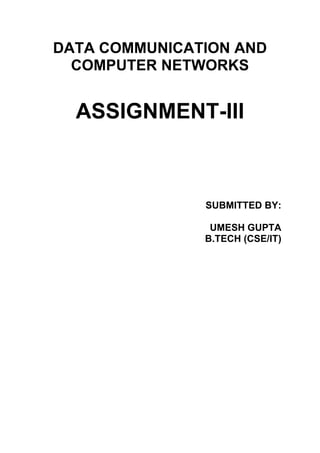
Leaky bucket algorithm
- 1. DATA COMMUNICATION AND COMPUTER NETWORKS ASSIGNMENT-III SUBMITTED BY: UMESH GUPTA B.TECH (CSE/IT)
- 2. CONTENTS Leaky Bucket Algorithm Token Bucket Algorithm
- 3. Leaky Bucket Algorithm Consider a Bucket with a small hole at the bottom, whatever may be the rate of water pouring into the bucket, the rate at which water comes out from that small hole is constant. This scenario is depicted in figure 1(a). Once the bucket is full, any additional water entering it spills over the sides and is lost (i.e. it doesn’t appear in the output stream through the hole underneath). The same idea of leaky bucket can be applied to packets, as shown in Fig. 1(b). Conceptually each network interface contains a leaky bucket. And the following steps are performed: When the host has to send a packet, the packet is thrown into the bucket. The bucket leaks at a constant rate, meaning the network interface transmits packets at a constant rate. Bursty traffic is converted to a uniform traffic by the leaky bucket. In practice the bucket is a finite queue that outputs at a finite rate. This arrangement can be simulated in the operating system or can be built into the hardware. Implementation of this algorithm is easy and consists of a finite queue. Whenever a packet arrives, if there is room in the queue it is queued up and if there is no room then the packet is discarded . (a) (b) Figure 1.(a) Leaky bucket (b) Leaky bucket implementation
- 4. Token Bucket Algorithm The leaky bucket algorithm described above, enforces a rigid pattern at the output stream, irrespective of the pattern of the input. For many applications it is better to allow the output to speed up somewhat when a larger burst arrives than to loose the data. Token Bucket algorithm provides such a solution. In this algorithm leaky bucket holds token, generated at regular intervals. Main steps of this algorithm can be described as follows: In regular intervals tokens are thrown into the bucket. The bucket has a maximum capacity. If there is a ready packet, a token is removed from the bucket, and thepacket is send. If there is no token in the bucket, the packet cannot be send. Figure 2.1 shows the two scenarios before and after the tokens present in the bucket have been consumed. In Fig. 2.1(a) the bucket holds two tokens, and three packets are waiting to be sent out of the interface, in Fig. 2.1(b) two packets have been sent out by consuming two tokens, and 1 packet is still left. The token bucket algorithm is less restrictive than the leaky bucket algorithm, in a sense that it allows bursty traffic. However, the limit of burst is restricted by the number of tokens available in the bucket at a particular instant of time. The implementation of basic token bucket algorithm is simple; a variable is used just to count the tokens. This counter is incremented every t seconds and is decremented whenever a packet is sent. Whenever this counter reaches zero, no further packet is sent out as shown in Fig. 1.2
- 5. Figure 2.1(a) Token bucket holding two tokens, before packets are send out, (b) Token bucket after two packets are send, one packet still remains as no token is left Figure 2.2 Implementation of the Token bucket algorithm
